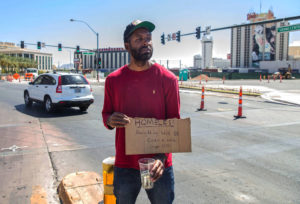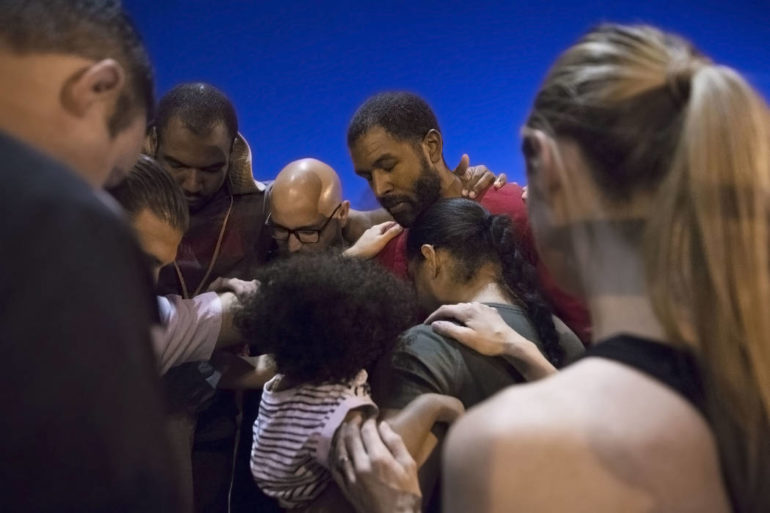On a daily basis, individuals who are homeless across the United States experience threats to their emotional, physical, and psychological well-being. Homelessness is a serious problem in mostly all metropolitan areas, including Las Vegas, Nevada, which is where I reside. On my daily route to and from work, I encounter scores of homeless individuals camped out on sidewalks; individuals spilling into the streets due to the lack of space on the over-crowded sidewalks. Despite my regular outreach over the years to those experiencing homelessness, I always felt a sense of hopelessness and frustration. The homeless population, just like any other population, deserves effective solutions to eradicate a social ill that is seemingly worsening, not only in my community, but around the country.
Homeless undercover experience
During the record-breaking hot summer of 2018 in Downtown Las Vegas, I decided to embark on a radical journey that would have me going undercover as a homeless man for 48 hours. Forty-eight hours, though not an extensive amount of time, left me hopeful that something would be gleaned to address the issue of homelessness. On August 31, 2018, with no money or resources in hand, I left the comfort of my world behind. I was fully aware of the risks involved, but I felt convicted to do something beyond my own imagination. Ironically, shortly after I committed to embark on my homeless journey, a man in the Downtown area was randomly killing homeless people. The man was arrested several days after killing multiple people, but the random violence put the homeless community on edge.
Prior to my homeless journey, the question I always struggled with was, why are the homeless often victims of violence? Research suggests that homelessness substantially increases vulnerability to violence victimization for those who have been homeless for a prolonged period of time (Meinbresse et al., 2014). In addition, women are at increased risk of victimization and often require additional protections that are often difficult to access (Phipps, Dalton, Maxwell, & Cleary, 2018).

I could feel my body go into a hyperarousal state within the first few hours of living on the streets.
Even during the short period of time of my homeless experience, I encountered a woman who had abruptly left a relationship where she was experiencing ongoing domestic violence. On the day that I met her, she was hiding in a makeshift tent, caring for an infant and a toddler. With fresh wounds across her face and body, the woman shared with me that she met her abuser while homeless and that she was often the target of violence when she lived on the streets.
Throughout my 48-hour experience, I slept very little, and I made sure that I was always fully aware of my surroundings. I felt this constant bullseye on my back, even during the daytime. It was interesting because as the time passed, I felt a shift. I started to realize that I felt safer and more accepted amongst other homeless men and women. The stares, the ridicule, and the proclivity of humanity to shame the homeless was apparent. Each time I tried to catch a reprieve from the heat by occasionally going inside a casino, I was escorted out. I even tried walking into the gym, where I was a long-time member, simply to use the restroom. I was immediately turned away, but after spending close to 10 minutes explaining, and trying to prove who I really was, I was eventually permitted to enter the gym.
I could feel my body go into a hyperarousal state within the first few hours of living on the streets. The constant need to be on alert started to take a toll, and by the second night, I fell asleep in front of a busy bus stop. I woke up frantically because I knew that I put myself in a vulnerable position. Even while lying in a park, I encountered two men who looked suspicious. Each timed I closed my eyes and opened them, the two men would seemingly inch closer to me. After several minutes of this, I started to walk towards the exit of the park, when one of the men approached me and admitted they were planning to rob me. I was physically, mentally, and emotionally drained from the totality of the experience.
Understanding the correlation of violence
The best way to understand the relationship of violence is to first understand the pathways to homelessness (Edalati, Krausz, & Schutz, 2016). The most common pathways being trauma, adverse childhood experiences, mental and physical health issues, barriers to accessing treatment and providers, and a lack of familial and social support (Phipps et al., 2018). When I experienced homelessness, of the 12 folks who befriended me, all fell into one of these categories, but mental health seemed to be the most common thread. Among these individuals was a woman, a former nurse, who was diagnosed with stage 3 breast cancer. She had to quit her lucrative emergency room career at a research hospital to undergo an aggressive treatment regimen. In the process, she lost her home, and she did not have an adequate support system to help her stay on her feet. When I met her, she was living in a shelter and was only given several months to live. I met several individuals that weekend, where their respective mental health conditions were the culprit, but her experience struck me the hardest. As a helping professional, when it was time to receive help for her own predicament, it was not reciprocated.
Lenient laws

I started working with the homeless population in 2013, and something that always stood out to me was the leniency of the laws towards the perpetrators who committed crimes against this population. I feel as though the homeless population is as at risk as other vulnerable populations, but historically lacked the same protections. For decades, enhancements to crimes against homeless individuals were not added, which was perplexing because these additional enhancements lengthened the punishments of the perpetrators (Steiner, 2009). Hate crimes are intended to punish the discriminatory selection of crime victims because of an actual variable such as race or sexual orientation (Levin, 2015). More than 40 states have enacted these statutes along with the support of the federal government, but enforcement of these laws and the groups covered bythem varies significantly based on the respective state (Levin, 2015). This is why there are discrepancies in the laws for the same types of crimes committed against the same group of people across different jurisdictions. As hate crime laws extend across jurisdictions nationwide, the groups the laws should protect the most, such as the homeless population, should occur more frequently (Levin, 2015). There has been a paradigm shift over the last decade, which has gleaned more credence towards protecting one of the nation’s most vulnerable populations, the homeless. The hope is that with stricter laws, victimization will decrease.
Treatment Implications
Research suggests that intervention programs within the homeless population should focus on the history of childhood trauma and its characteristics to increase the effectiveness of intervention strategies (Rattelade, Farrell, Aubry, & Klodawsky, 2014). In addition to providing trauma-based approaches, something that I have experienced clinically, as well as during my homeless experience, is the deep-rooted mistrust that individuals experiencing homelessness exhibit towards systems and providers. I strongly believe that outreach and clinical intervention would be better served in a mobile fashion. Expecting individuals who may be lacking basic necessities, to show up for therapy or medication management appointments is not reasonable. Meeting people where they are should be the focus. In addition, relationship building is of utmost importance. Providers who are intentional about building rapport, help to combat the mistrust this population has towards others.
Conclusion
Homelessness is a pervasive issue with no end. There are many layers that only add to the complexity of this issue, and mental health is at its core. I feel that the decades of a failing mental health system have greatly contributed to our homeless issue. The system never learned how to treat individuals experiencing severe mental illness (SMI). The way humanity treats others, the lack of resources, and the traumatic nature of the environment, make it almost impossible to endure. The prevalence of violence, and experiencing it directly, or even indirectly, is going to have an impact on one’s mental wellbeing. Affordable housing is no longer affordable. And self-preservation is just a means to survival (Edalati, Krausz, & Schutz, 2015).
Yet, despite the high numbers of homelessness across our nation, there is a silver lining. With the changes in the laws towards perpetrators who commit violence towards the homeless, there is hope that a decrease in violent crimes will occur. And bringing awareness to mental health needs may lead individuals experiencing homelessness to feel heard, safe, and thus hopeful for a better outcome. And that might be all that we can ask for.
Photos: Benjamin Hager, Las Vegas Review Journal.

Sheldon A. Jacobs, PsyD, LMFT, is an AAMFT Professional member holding the Clinical Fellow designation. He is owner of Dr. Sheldon A. Jacobs Counseling Services, is on the Board of Directors, NAMI National, Vice President NAMI-Southern Nevada, and State of Nevada Board of Examiners for MFTs & CPCs. Jacobs is also author of 48: An Experiential Memoir on Homelessness.
REFERENCES
Edalati, H., Krausz, M., & Schutz, C. (2016). Childhood maltreatment and revictimization in a homeless population. Journal of Interpersonal Violence, 31(14), 2492-2512.
Levin, B. (2015). Reassessing laws on hate violence against the homeless. American Behavioral Scientist, 59(13), 1715-1728.
Meinbresse, M., Brinkley-Rubinstein, L., Grassette, A., Benson, J., Hamilton, R., Malott, M., & Jenkins, D. (2014). Exploring the experiences of violence among individuals who are homeless using a consumer-led approach. Violence and Victims, 29(1), 122-136. https://doi.org/10.1891/0886-6708.vv-d-12-00069
Phipps, M., Dalton, L., Maxwell, H., & Cleary, M. (2018). Women and homelessness, a complex multidimensional issue: Findings from a scoping review. Journal of Social Distress and Homelessness, 28, 1-94.
Rattelade, S., Farrell, S., Aubry, T., & Klodawsky, F. (2014). The relationship between victimization and mental health functioning in homeless youth and adults. Journal of Interpersonal Violence, 29, 1606-1622.
Steiner, S. (2009). Habitations of cruelty: The pitfalls of expanding hate crime legislation to include the homeless. Criminal Law Bulletin, 45(4).
Other articles
Intimate Partner Violence and Black Women
Many people have asked me, “What is intimate partner violence (IPV) and why is it important to me if I don’t specialize in treating it?” IPV is a social ill that includes, but is not limited to, physical violence, emotional violence, psychological violence, and sexual violence.
Lorin Kelly, PhD
Effects of IPV on Immigrant Latinas
Intimate partner violence (IPV) is defined as domestic violence perpetuated by someone onto another person in an intimate relationship. IPV can take different forms, such as physical, verbal, sexual, or psychological abuse.
Jacqueline Florian, MA
Can Suicide Protocols Empower Clients? From Assessment to Assistance
The COVID-19 pandemic has skyrocketed the demand for mental health services in many locations, city and rural areas alike (Richtel, 2022). Experiences such as loss of loved ones, disappearance of jobs, derailing of social activities, isolation, depression, alienation, etc., have contributed to an increase in people thinking of the unthinkable: ending their lives.
M. N. Beaudoin, PhD




